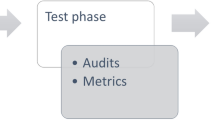Abstract
We discuss the design and evaluation of a class of agents that we call adaptive web site agents. The goal of such an agent is to help a user find additional information at a particular web site, adapting its behavior in response to the actions of the individual user and the actions of other visitors to the web site. The agent recommends related documents to visitors and we show that these recommendations result in increased information read at the site. It integrates and coordinates among different reasons for making recommendations including user preference for subject area, similarity between documents, frequency of citation, frequency of access, and patterns of access by visitors to the web site. We argue that this information is best used not to change the structure or content of the web site but rather to change the behavior of an animated agent that assists the user.
Similar content being viewed by others
References
R. Armstrong, D. Freitag, T. Joachims, and T. Mitchell, “WebWatcher: A learning apprentice for the World Wide Web,” in Proc. 1995 AAAI Spring Symposium on Information Gathering from Heterogeneous, Distributed Environments, Stanford, AAAI Press, 1995.
S. Brin and L. Page, “The anatomy of a large-scale hypertextual Web search engine,” in 7th Int. World Wide Web Conference, Brisbane, Australia, 1998, pp. 107-117.
T. Bickmore, L. Cook, E. Churchill, and J. Sullivan, “Animated autonomous personal representatives,” in Proc. Second Int. Conf. Autonomous Agents, Minneapolis, MN, 1998, pp. 8-15.
J. Budzik, K. J. Hammond, C. Marlow, and A. Scheinkman, “Anticipating information needs: Everyday applications as interfaces to Internet information sources,” in Proc. 1998 World Conference on the WWW, Internet, and Intranet, AACE Press, 1998.
K. Bollacker, S. Lawrence, and C. L. Giles, “CiteSeer: An autonomous Web Agent for automatic retrieval and identification of interesting publications,” in Proc. 2nd Int. ACM Conf. Autonomous Agents, 1998, pp. 116-123.
R. Burke, K. Hammond, and B. Young, “The FindMe approach to assisted browsing,” IEEE Expert/ Intelligent Systems & Their Applications, vol. 12, no. 4, pp. 32-40, 1997.
J. Fink, A. Kobsa, and A. Nill, “User-oriented adaptivity and adaptability in the AVANTI project,” Designing for the Web: Empirical Studies, Microsoft Usability Group: Redmond, WA, 1996.
D. O. Hebb, The Organization of Behavior, New York: Wiley, 1949.
T. Joachims, D. Freitag, and T. Mitchell, “WebWatcher: A tour guide for the World Wide Web,” in Fifteenth Int. Joint Conf. Artificial Intelligence, 1997.
H. Lieberman, “Letizia: An agent that assists web browsing,” in Proc. Int. Joint Conf. Artifi. Intell. Montreal, 1995.
P. Maes, “Agents that reduce work and information overload,” Commun. ACM, vol. 37, no. 7, pp. 31-40, 1994.
N. Megiddo and R. Srikant, “Discovering predictive association rules,” in Proc. Fourth Int. Conf. Knowledge Discovery in Databases and Data Mining, New York, 1998.
C. Merz and M. Pazzani, “A principal components approachto combining regression estimates,” Machine Learning, vol. 36, pp. 9-32, 1999.
M. Pazzani and D. Billsus, “Learning and revising user profiles: The identification of interesting web sites,” Machine Learning, vol. 27, pp. 313-331, 1997.
M. Perkowitz and O. Etzioni, “Adaptive web sites: An AI challenge,” in Proc. IJCAI97, 1997a.
M. Perkowitz and O. Etzioni, “Adaptive web sites: Automatically learning from user access patterns,” in Proc. WWW6, 1997b.
M. Perkowitz and O. Etzioni, “Adaptive web sites: Automatically synthesizing web pages,” in Proc. AAAI98, 1998.
B. Rhodes and T. Starner, “Remembrance agent: A continuously running automated information retrieval system,” in Proc. First Int. Conf. The Practical Application of Intelligent Agents and Multi Agent Technology, 1996, pp. 487-495.
T. Rist, E. André, and J. Müller, “Adding animated presentation agents to the interface,” in Proc. 1997 Int. Conf. Intell. User Interfaces, Orlando, FL, 1997, pp. 79-86.
G. Salton, Automatic Text Processing, Addison-Wesley, 1989.
N. Schraudolph and T. J. Sejnowski, “Competitive anti-Hebbian learning of invariants,” in Advances in Neural Information Processing Systems, vol. 4, pp. 1017-1024, Morgan Kaufmann: San Mateo, 1992.
L. G. Terveen and W. Hill, “Human-computer collaboration in recommender systems,” in J. Carroll (ed.), HCI in the New Millennium, Addison Wesley, in press.
A. Wexelblat and P. Maes, Using History to Assist Information Browsing, RIAO'97: Computer-Assisted Information Retrieval on the Internet, Montreal, 1997.
Author information
Authors and Affiliations
Rights and permissions
About this article
Cite this article
Pazzani, M.J., Billsus, D. Adaptive Web Site Agents. Autonomous Agents and Multi-Agent Systems 5, 205–218 (2002). https://doi.org/10.1023/A:1014849311433
Issue Date:
DOI: https://doi.org/10.1023/A:1014849311433




